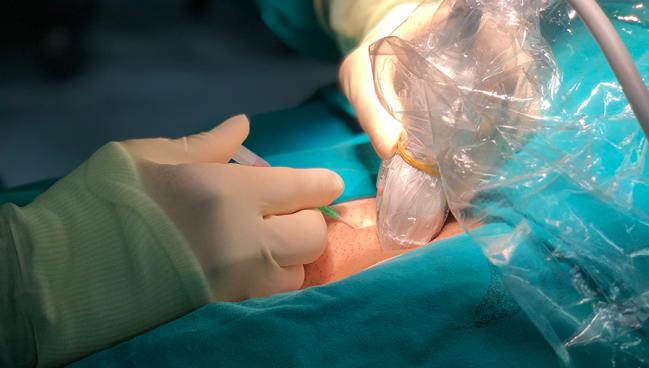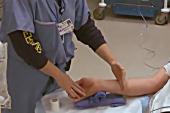Ultrasound Cuts Vascular Complications, Bleeds in Transfemoral Access
A new meta-analysis shows a “clear benefit” when using “risk free” ultrasound in these procedures, the study author says.

The study includes data from the UNIVERSAL trial, which, as reported by TCTMD, missed its primary endpoint, failing to prove that adding ultrasound guidance in these cases reduces bleeding or vascular complications. UNIVERSAL did, however, indicate that ultrasound use lowers the risk of venipuncture and the number of arterial puncture attempts. Some, including the authors of that trial, argued that it might have shown more of an effect had it been larger and had BARC 2 bleeding not been included as part of the primary endpoint.
Learning from UNIVERSAL, lead author Marc-André d’Entremont, MD (Population Health Research Institute, Hamilton, Canada), told TCTMD that for this meta-analysis, they removed BARC 2 bleeding from the primary endpoint and focused on major complications that are typically linked with mortality. With that shift in focus, the study “shows that ultrasound should be used to get this clear benefit . . . for coronary procedures,” he said.
Alexander Fanaroff, MD (Perelman School of Medicine, Philadelphia, PA), commenting on the study for TCTMD, said that this analysis adds a more rigorous confirmation that “ultrasound guidance reduces vascular access complications, which is what you expect it to do.”
Ultrasound, despite being present in most US cath labs, isn’t always available, he acknowledged. Still, Fanaroff challenged any interventional cardiologist, if they were undergoing PCI with transfemoral access, “to say they wouldn't want ultrasound used, assuming it's being done by an operator who has some training in ultrasound guided access. . . . The common femoral artery is a relatively short segment, it's relatively deep, and it's easy to stick [the needle] in the wrong spot if you can't see what you are doing. And fluoroscopic landmarks just aren't enough.”
Meta-analysis Findings
For the study, published online today in EuroIntervention, d’Entremont and colleagues included 2,441 patients (mean age 65.5 years; 27.0% female) undergoing transfemoral coronary procedures from four trials: FAUST (n = 1,004), a study by Marquis-Gravel et al (n = 128), SURF (n = 688), and UNIVERSAL (n = 621). Slightly more than one-third (34.5%) underwent PCI, and 49.5% were randomized to ultrasound guidance.
The incidence of the primary composite outcome, major vascular complications or BARC 3 or 5 bleeding, was lower for those who had ultrasound guidance as compared with those who did not (2.8% vs 4.5%; OR 0.61; 95% CI 0.39-0.94). Interestingly, when BARC 2 bleeding was included in the composite outcome, the effect was no longer statistically significant (4.6% vs 6.2%; OR 0.70; 95% CI 0.49-1.01). Also, both the number of attempts (1.42 vs 2.21; OR -7.8; 95% CI -0.93 to -0.64) and risk of venipuncture (5.3% vs 14.1%; OR 0.33; 95% CI 0.25-0.46) were lower with ultrasound guidance.
Notably, in a subgroup analysis of those who received a vascular closure device (50.9%), ultrasound guidance also was associated with a reduction in the primary outcome compared with usual care (2.1% vs 5.6%; OR 0.36; 95% CI 0.19-0.69). No benefit was observed among those without vascular closure devices (4.1% vs 3.3%; OR 1.21; 95% CI 0.65-2.26; P for interaction = 0.009).
d'Etremont said these results definitively answer the question of whether ultrasound should be used in all transfemoral procedures, at least in the coronary space. “It’s something that is risk free,” he said. “I don't see much of a downside to it. There are a few pitfalls when you're learning to do the procedure of kind of following the needle in real time and making sure you don't go too deep or too far. But once you've learned the technique, I don't see why you shouldn't use it every time systematically.”
For structural and chronic total occlusion cases using larger-bore sheaths, more data are needed, he added.
Barriers and Implementation
Fanaroff believes a lack of training is likely the biggest barrier to ultrasound use in transfemoral procedures. “Until recently, it hasn't been standard of care, and I think that a lot of operators that trained before it was standard of care didn't use it,” he said. “They didn't use it in training, so they did not become as confident with it as operators that are training now have become.”
Fanaroff noted that it takes slightly more time to set up the ultrasound, particularly in hospitals that don’t have dedicated machines for each cath lab.
In general, “the nature of progress in medicine and cardiovascular medicine is slow,” he said. An important next step will be to research barriers to implementation of ultrasound: ”How do you make sure that that you get ultrasound access for every femoral stick? How do you take operators that trained a while ago and are really good at femoral access but not ultrasound techniques [and] convince them that this is the right thing to do? And how you make them comfortable with using ultrasound?”
Research should also address potential gaps in access, Fanaroff added. Not all hospitals may have the resources to invest in dedicated ultrasound machines for transfemoral procedures and not all patients can pay for add-on costs.
Yael L. Maxwell is Senior Medical Journalist for TCTMD and Section Editor of TCTMD's Fellows Forum. She served as the inaugural…
Read Full BioSources
d’Entremont M-A, Alrashidi S, Seto AH, et al. Ultrasound guidance for transfemoral access in coronary procedures: an individual participant-level data meta-analysis from the femoral ultrasound trialist collaboration. EuroIntervention. 2023;Epub ahead of print.
Disclosures
- d’Etremont and Fanaroff report no relevant conflicts of interest.





Comments